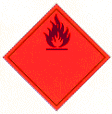| Rum | [German version] |
Table of contents |
|
| General: | ||
| Product information | ||
| Packaging | ||
| Transport | ||
| Container transport | ||
| Cargo securing | ||
Product information
Product name
| German | Rum (Flaschen) |
| English | Rum (bottles) |
| French | Rhum (bouteilles) |
| Spanish | Ron (botellas) |
| Scientific | |
| CN/HS number * | 2208 40 ff. |
(* EU Combined Nomenclature/Harmonized System)
Product description
Rum is a fine spirit, obtained by distillation from sugar cane, sugar cane molasses and other residues of sugar processing.
The main distillate, which is produced in pot stills (distillation boilers), has an alcohol content of 80 – 88 vol.%. It is then stored in oak kegs. Rums are classed as follows:
| Original rum: produced in the exporting countries. No changes are made in the importing country. | |
| Overseas rum: imported with an alcohol content of 75 vol.% and reduced to a drinking strength of 40 – 45 vol.%. |
A distinction is drawn between the following types of rum on the basis of their aroma:
| Cuban rum: light, brandy-like aroma | |
| Jamaica rum: intense, full-bodied aroma | |
| Martinique rum: strong, heavy aroma |
Although rum does not spoil easily due to its high ethyl alcohol content, as a cargo it does require care, to prevent quality degradation.
Quality / Duration of storage
The following distinction is drawn on the basis of color:
| White (light) rum, with an ethyl alcohol content of 40 vol.% | |
| Brown (dark) rum, e.g. Jamaica rum, with an ethyl alcohol content of 45 – 50 vol.% |
Maximum duration of storage is as follows:
| Temperature | Relative humidity | Max. duration of storage | Source |
|---|---|---|---|
| 10 – 20°C | 70% | > 6 months | [1] |
Intended use
Rum is used primarily for mixing alcoholic beverages.
It is also used for flavoring confectionery (rum truffles), chocolate, cakes and pastries, for preserving fruit and for consumption neat.
Countries of origin
Distillation of residues from the sugar cane industry takes place principally on the islands of the Caribbean (Jamaica, Cuba, Martinique, Barbados) and in South America.
Back to beginning
Packaging
Bottles in millboard cartons must be sealed by the packer with adhesive tape or special clips. Opening of the cartons either prior to packing or on unpacking of the containers is not permitted (risk of theft). Cartons which are damaged, stained with moisture or dry dirt, do not display their original seal or „rattle“ must not be loaded in containers. Markings should be visible on every side of the packaging:
| Marking of packages | ||
 Fragile, Handle with care |
 Top |
 Keep dry |
Back to beginning
Transport
Symbols
 High-proof rum in tanks and kegs with a flash point of below 23°C Fire hazard (Flammable liquid), Class 3 IMDG Code |
 General cargo |
 Liquid cargo |
Means of transport
Ship, truck, railroad, aircraft
Container transport
Bottles in cartons are mainly transported in standard containers, subject to compliance with limits for water content of packaging and container flooring.
Liquid cargo is transported in tank containers suitable for foodstuffs.
Cargo handling
The safest way to handle bottles in cartons is on pallets. Due to their moisture sensitivity, the packages must be protected from rain, snowfall etc.
Stowage factor
| 1.80 – 2.00 m3/t (millboard cartons) [1] | |
| 1.63 – 1.87 m3/t (boxes) [1] | |
| 1.87 – 2.01 m3/t (kegs) [1] | |
| 1.84 – 1.95 m3/t (kegs, tank containers etc.) [11] |
Stowage space requirements
Due to the risk of overheating, it is best, where possible, not to stow containers on deck in uppermost tiers and outer rows or near heat sources. In the event of conventional loading, stow in lockers due to risk of theft.
Segregation
Marker pen/oil crayon
Cargo securing
Because of its considerable impact- and pressure-sensitivity, packages of this cargo must be secured in such a way that they are prevented from damaging each other. Spaces between packages or pallets must be filled, to prevent slippage or tipping. By selecting the correct packaging size or cargo unit (area module or area module multiple), holds can be tightly loaded (without spaces).
In the case of liquid cargoes, it is important for the ullage space above the cargo to be as small as possible, so that only slight movement of the cargo is possible. Movement in liquid cargoes may have a negative effect on the stability of the means of transport (e.g. during cornering in the case of trucks and trains).
Back to beginning
Risk factors and loss prevention
RF Temperature
Rum (bottles) requires particular temperature, humidity/moisture and possibly ventilation conditions (SC VI) (storage climate conditions)
| Designation | Temperature range | Source |
|---|---|---|
| Travel temperature | 10 – 20°C | [1] |
At excessively high temperatures, expansion in volume (dilatation) may occur, causing the closures to loosen and evaporation losses to occur. These depend on the coefficient of thermal expansion, which at 18°C is 0.00110°C-1 for ethyl alcohol but only 0.00018°C-1 for water. For this reason, alcoholic beverages, such as rum, are more prone to thermal dilatation than alcohol-free beverages.
Temperatures > 25°C or solar radiation cause discoloration, resinification of the essential oils, oxidation phenomena and the breakdown of quality-determining aromatic substances.
Temperatures < 10°C cause separation, and sedimentation of coloring substances occurs. Chill haze does not impair flavor and quality, however, and may be reversed at temperatures > 18°C.
Temperatures < 0°C may cause a reduction in the volume of the contents, giving the impression of shortage.
Back to beginning
RF Humidity/Moisture
Rum (bottles) requires particular temperature, humidity/moisture and possibly ventilation conditions (SC VI) (storage climate conditions)
| Designation | Humidity/water content | Source |
| Relative humidity | 70% | [1] |
| Water content | 5 – 8% (relative to the paperboard constituting the cartons) | [1] |
| Maximum equilibrium moisture content | 70% (relative to the paperboard constituting the cartons) | [1] |
If rum (bottles) is loaded in a standard container, it must be protected from all forms of moisture (seawater, rain and condensation water) and from excessive relative humidities. A relative humidity > 70% has a negative effect on the appearance of the bottles due to wetting and detachment of the label. The product is then no longer fit for sale as original bottled produce.
Upon loading in a container, care must be taken to ensure that the wooden flooring of the container is completely dry, to avoid an additional source of water vapor. A water content of 12 – 15% results in an equilibrium moisture content in the container of 65 – 70%. The water content of the paperboard should be 5 – 8%. The cartons should be covered with packing paper, gunny cloth or the like to provide protection against dripping sweat.
Back to beginning
RF Ventilation
Rum (bottles) requires particular temperature, humidity/moisture and possibly ventilation conditions (SC VI) (storage climate conditions)
Normally, the cargo does not need to be ventilated. However, if there is a risk of cargo sweat, which may result, for example, in wetting of the paperboard cartons and thus in a reduction in stability and strength, the following ventilation measure is recommended:
Recommended ventilation conditions: air exchange rate: 6 changes/hour (airing)
Back to beginning
RF Biotic activity
Rum (bottles) displays 4th order biotic activity.
Rum belongs to the class of goods in which biochemical and microbial processes have stopped and which are isolated from the external environment, e.g. sterilized and pasteurized goods in hermetically sealed packaging.
Back to beginning
RF Gases
No risk.
Back to beginning
RF Self-heating / Spontaneous combustion
High-proof rum in tanks or kegs with a flash point of below 23°C (e.g. 54 vol.% rum: flash point approx. 22°C) is assigned to Class 3 of the IMDG Code.
Leakage results in a fire hazard.
Back to beginning
RF Odor
| Active behavior | The hermetically sealed packaging prevents the development of any odor. |
| Passive behavior | The packaging of the bottles (paperboard cartons) is sensitive to all types of foreign odor. |
Back to beginning
RF Contamination
| Active behavior | Contamination arises only in the event of leakage due to breakage. |
| Passive behavior | The packaging of the bottles (paperboard cartons) is sensitive to dirt, fats and oils. Holds/containers must therefore be clean and in a thoroughly hygienic condition. |
Back to beginning
RF Mechanical influences
The bottles and their packaging are particularly sensitive to impact and compressive stresses. Improper handling or stowage may result in damage. Stacked cartons which have become damp may give way and collapse. It is essential to provide cartons with the following markings: „Top“, „Fragile, „Handle with care“ and „Keep dry“. Improper handling may result, for example, in detachment of the adhesive strips or damage to the carton walls and edges. In addition, under more extreme stresses, such as dropping of the cartons, the bottles may break, causing leakage.
Back to beginning
RF Toxicity / Hazards to health
No risk.
Back to beginning
RF Shrinkage/Shortage
As rum is a relatively valuable cargo, there is considerable risk of theft. Cartons which „rattle“ indicate short quantities. Containers should where possible be stowed such that the doors of adjacent containers block each other, thereby preventing access to the container interior. Where conventional shipment is used, the cargo should be stowed in a locker.
Volume may also be lost due to breakage resulting from improper handling.
Back to beginning
RF Insect infestation / Diseases
No risk.
Back to beginning
